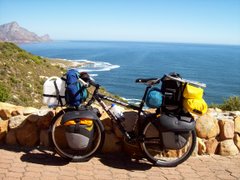





Some time around 1650 a Dutch official of the VOC in Batavia committed some sin, and as punishment he was ordered to establish a replenishment station at the Cape of Good Hope. The ships in picture are not quite the Drommedaris, Reigger, and De Goede Hoop with which Jan Van Riebeeck sailed to the present-day Cape Town (my home-town). However, the old Sunda Kelapa harbour in present-day Jakarta - once the booming centre of the spice trade - is still in operation, with rows of interesting old wooden trading ships lining the quays (of course, there is also another modern harbour). Otherwise there's not much left to see of the once prosperous Batavia, the place to which Van Riebeeck longed to return (of course there wasn't much amusement in Cape Town at that time). This historic old colonial part of Jakarta is pretty much going to the dogs, with crumbling old buildings, slummy areas, and the stinking polluted canal. Otherwise the city of Jakarta is a large, modern metropolis - the 9th largest in the world with about 17 million inhabitants. Leana and I have been here almost a week, relaxing, servicing the bicycles, repairing things, and stocking up on things which we've been unable to find elsewhere. Although the city is very spread out, there is a suburban railway station close to where we're staying, and the bus service as also quite ok. Jakarta is not quite as smooth and efficient as Bangkok or Kuala Lumpur, and certainly not as clinical as Singapore. Yesterday we celebrated our 3rd anniversary on the bicycles - 3 years on the road since leaving Tableview beach on 27 March 2007. We splashed out a bit, and celebrated by enjoying a couple of the local Bintang beers at a little place around the corner - incidently on their opening night. We'll probably move on East through Java Island tomorrow, I'm not sure by which route but there are lots of volcanoes which Leana wants to see (and I see hills again in my nightmares!). In case you didn't know, Indonesia is the world's 4th most populous country, and more than 50% of those people live on Java island. Thus far we've only cycled a short distance in Java, which has been built-up all the way with lots of traffic (especially motorbikes and mini-bus taxis). So, for the next few weeks I see myself struggling up hills, while at the same time trying to survive by dodging the traffic (I won't even mention the heat and humidity!). It may sound as though I'm complaining, but after 3 years I still wouldn't swap this lifestyle for any other! Daily distances cycled since my last report from Cilegon have been:- Tangerang 91 km; and Jakarta 31 km. Total distance cycled in the past 3 years from Cape town to Jakarta is 56 816 km.




















